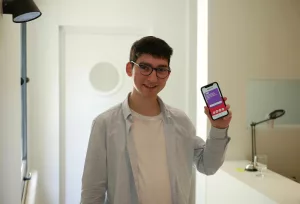The constructive journalism panel held on February 22 by IE University’s School of Politics, Economics, and Global Affairs (SPEGA) in collaboration with the IE Stork and El Instituto de Periodismo Constructivo marked the end of the competition and series of talks. Held by SPEGA’s Associate Vice Dean, Borja Santos, and moderated by the Stork’s Editor in Chief, Roché Smith Rabie, the conversation revolved around the future of journalism. Specifically addressed were the changes the field of journalism and its actors must undertake to be a positive force in society.
The panel was composed of three experts in the journalistic profession: Alfredo Casares, the founder and director of the Instituto de Periodismo Constructivo, an institution offering workshops and advice to students and companies alike on constructive journalism; David Jiménez, writer and columnist for the New York Times and previously Editor in Chief for the Spanish newspaper El Mundo; and Mónica Prado, Editor in Chief of the Digital Area of television station Antena 3 Noticias. As such, the panel represented an expansive knowledge of journalism in the sphere of newspapers, television and even initiatives that support and uplift media powers.
The talk began with the announcement of the winners of the Constructive Journalism Competition. Grace Berry, the editor for the Stork’s news section, took home the first prize with her analysis of the educational opportunities given by the Education Scholarship Account for disabled students in Arizona, USA. Mariano Eduardo Abad Colin won 2nd place with his article that evaluates Gijón’s response to the environmental and social problems of Urban Mobility, specifically in regard to the Sustainable Mobility Plan of 2021-2030. These articles will be published on the Stork’s website.

Photo by Marie-Therese Burkard.
At the heart of the panel’s conversation was why constructive journalism is especially important today. Speaking from his time covering wars and natural disasters, Jiménez explained “journalists are usually attracted to the negative.” Disturbing, enraging or horrifying news is what makes people watch, read and pay attention. As such, media companies and journalists have learned to follow the negative and construct a conflict-based narrative. This has only been amplified by the digital transformation of media, which makes it possible to track in real-time when people are watching and when they click away. The new digital tools therefore clearly illustrate that the shock factor of news is well rewarded in terms of numbers and hence profits. The result is a bias toward “bad news.”
As digitalization continues to increase and spread its influence in the forms of communication and access to news, the amount of information we consume increases accordingly. It is already visible that the overwhelming amount of negative news is pushing people away from news consumption. The most prominent example of this is the COVID-19 pandemic, where more and more people decided to stop watching and reading the newspaper due to the constant anxiety-inducing information surrounding COVID-related infections, deaths and further regulations.
The main argument, however, is that constructive journalism, an investigative and proposal-based approach to journalism, can be employed to transform the negatively biased state of journalism. While it is still important to report on wars, corruption and natural disasters, the approach can be different by portraying good news through the initial bad ones. Instead of simply going to a place of a natural disaster and reporting on the devastation and death, the same place could be visited a year later to illustrate the improvements made since then. In that manner, hope and the perseverance of the human spirit can be also communicated to the public.
Prado suggested that journalists need to work on rebuilding the public’s trust in media outlets again. By making news more shocking, talk shows more aggressive and stories faster, recent journalism has fostered an opportunity for disinformation and political polarization to emerge.
Casares explained that journalists need to play a different role than they have been for the last ten or even twenty years. As such, the question arises: what is the purpose of stories and journalism supposed to be today? The experts seemed to agree that it will take patience and persistence to transform the negatively constructed image of society into one that reflects the hope and beauty in the world as well.
In the words of Jiménez, “there are so many good stories to be told,” and the public deserves to hear them.
Cover image by: Cody Fenwick. Retrieved from 80,000 Hours.






